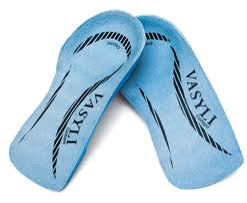At least 1 in 4 people with patellofemoral pain is likely to benefit from foot orthoses.1

But how do I know if my patient will be one of those people?
A simple test can show if the patient is likely to benefit:
Is pain decreased when squatting whilst wearing orthotics?
- Yes? Get a pair.
- No? Don’t get them.
Why might shoe inserts help?

Research suggests that shoe inserts will significantly help reduce pain in anywhere between 25 and 50% of people with patellofemoral pain over the first 6-12 weeks of treatment.1 They may also help in the longer term too.
Traditionally, shoe inserts have been provided to patients because they have flat (pronated) feet. However, there is a lot of debate about whether this is the right approach. In people with patellofemoral pain, having flatter feet does not predict strongly whether or not shoe inserts will help.2 Equally, shoe inserts can help people who are not considered to have flat feet.
A couple of studies have reported that people with flexible feet measured using a specific device are more likely to benefit from shoe inserts if they have patellofemoral pain.3
One of the simplest ways to work out if shoe inserts will help is to try them during an activity that normally causes pain. If the inserts immediately reduce pain, then they are likely to help. If they do not immediately reduce pain, they are unlikely to help. It is that simple!
In one study, this test was the strongest predictor of success with shoe inserts given to people with patellofemoral pain.4 In the same study, the amount of foot movement (pronation) occurring during walking also predicted success, but not as well.
Aren’t shoe inserts expensive?
If shoe inserts are customized specifically for the patient, they can be quite expensive. However, research tells us that this is not necessary for most people with patellofemoral pain.
Less expensive prefabricated shoe inserts (usually less than $100) can be used to treat patellofemoral pain.5 If the patients complete their rehabilitation exercises getting stronger, shoe inserts may only be needed for a short time.
References
- Barton 2011. The immediate effects of foot orthoses on functional performance in individuals with patellofemoral pain syndrome.
- Lack 2014. Outcome predictors for conservative patellofemoral pain management: a systematic review and meta-analysis.
- Mills 2012. A randomised control trial of short term efficacy of in-shoe foot orthoses compared with a wait and see policy for anterior knee pain and the role of foot mobility.
- Barton 2011. Clinical predictors of foot orthoses efficacy in individuals with patellofemoral pain.
- Barton 2010. The efficacy of foot orthoses in the treatment of individuals with patellofemoral pain syndrome: a systematic review.
